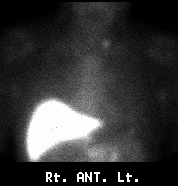Case Author(s): Lester Johnson, M.D., Ph.D. and Keith Fischer, M.D. , 1/14/00 . Rating: #D3, #Q5
Diagnosis: Metastatic prostate carcinoma
Brief history:
Previous radical prostatectomy for prostate carcinoma, now with rising serum prostate specific antigen (PSA).
Images:

Anterior image of the thorax is shown
View main image(pr) in a separate image viewer
View second image(pr).
Anterior image of the abdomen is shown
Full history/Diagnosis is available below
Diagnosis: Metastatic prostate carcinoma
Full history:
This 59-year-old male underwent radical prostatectomy 11 months earlier for Gleason 6 prostate carcinoma with perineural invasion. His preoperative serum PSA of 12 ng/ml decreased to 0.2 ng/ml postoperatively, but has now increased to 0.6 ng/ml. This examination is obtained to determine the extent of disease prior to radiotherapy.
Radiopharmaceutical:
ProstaScint (In-111 capromab pendetide)
Findings:
There is expected distribution of In-111 capromab pendetide in the blood pool, liver, bone marrow and gastrointestinal tract. There is also abnormal marked uptake in retroperitoneal lymph nodes in the lower abdomen and mesenteric lymph nodes in the mid-abdomen and left upper quadrant of the abdomen. In addition, abnormal marked uptake in a left supraclavicular lymph node is identified. Tomographic imaging of the pelvis (not shown) also demonstrated bilateral iliac lymph nodal activity. These findings are consistent with extensive lymph nodal involvement by metastatic prostate carcinoma.
Discussion:
This case demonstrates an unusually striking pattern of metastatic prostate cancer with involvement of multiple lymph node regions outside the pelvis. It is somewhat unusual for a Prostascint scan to be grossly positive even on planar images, as seen in this. Metastatic involvement is more typically identified in pelvic lymph nodes and is usually more difficult, requiring careful evaluation with SPECT imaging. This evaluation is often performed with dual isotope imaging using both Prostascint and tagged red blood cells, which help by localizing the blood pool activity.
ACR Codes and Keywords:
References and General Discussion of (Anatomic field:Genitourinary System, Category:Neoplasm, Neoplastic-like condition)
Search for similar cases.
Edit this case
Add comments about this case
Return to the Teaching File home page.
Case number: pr001
Copyright by Wash U MO

